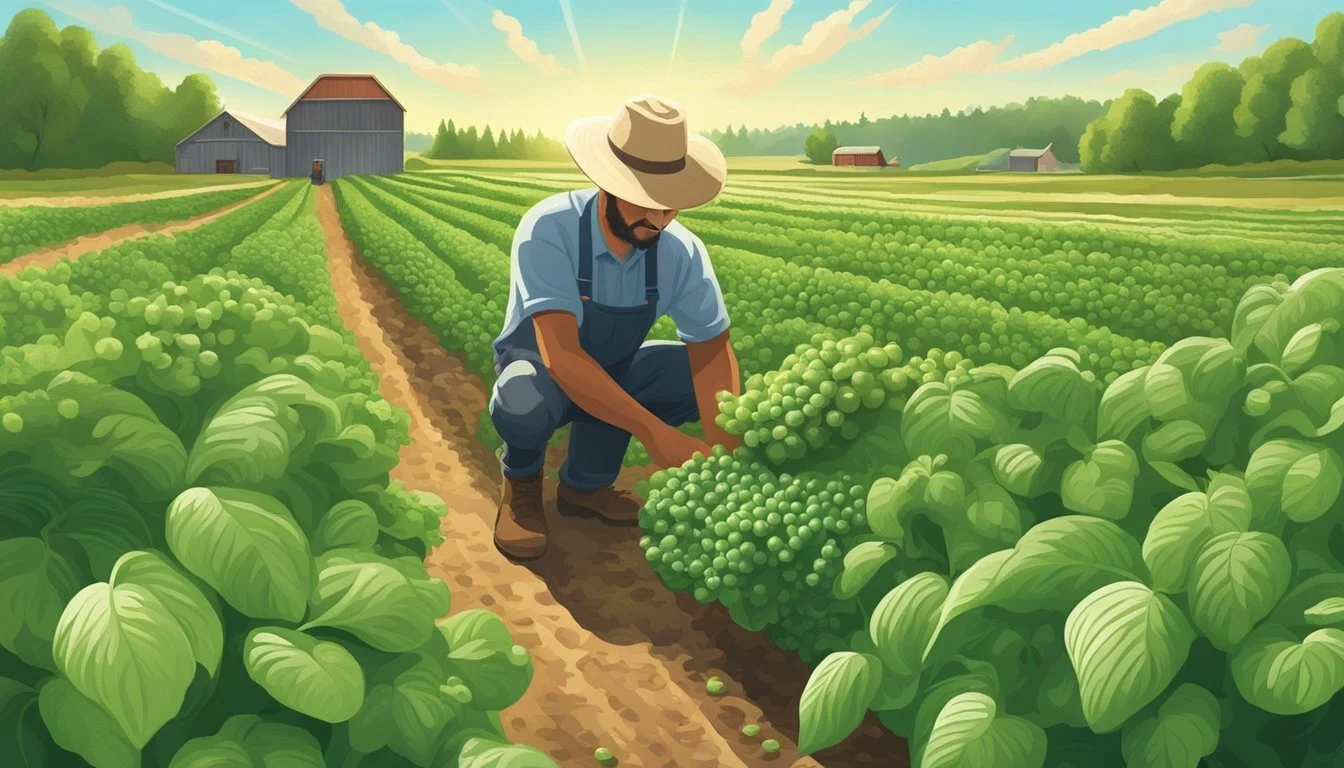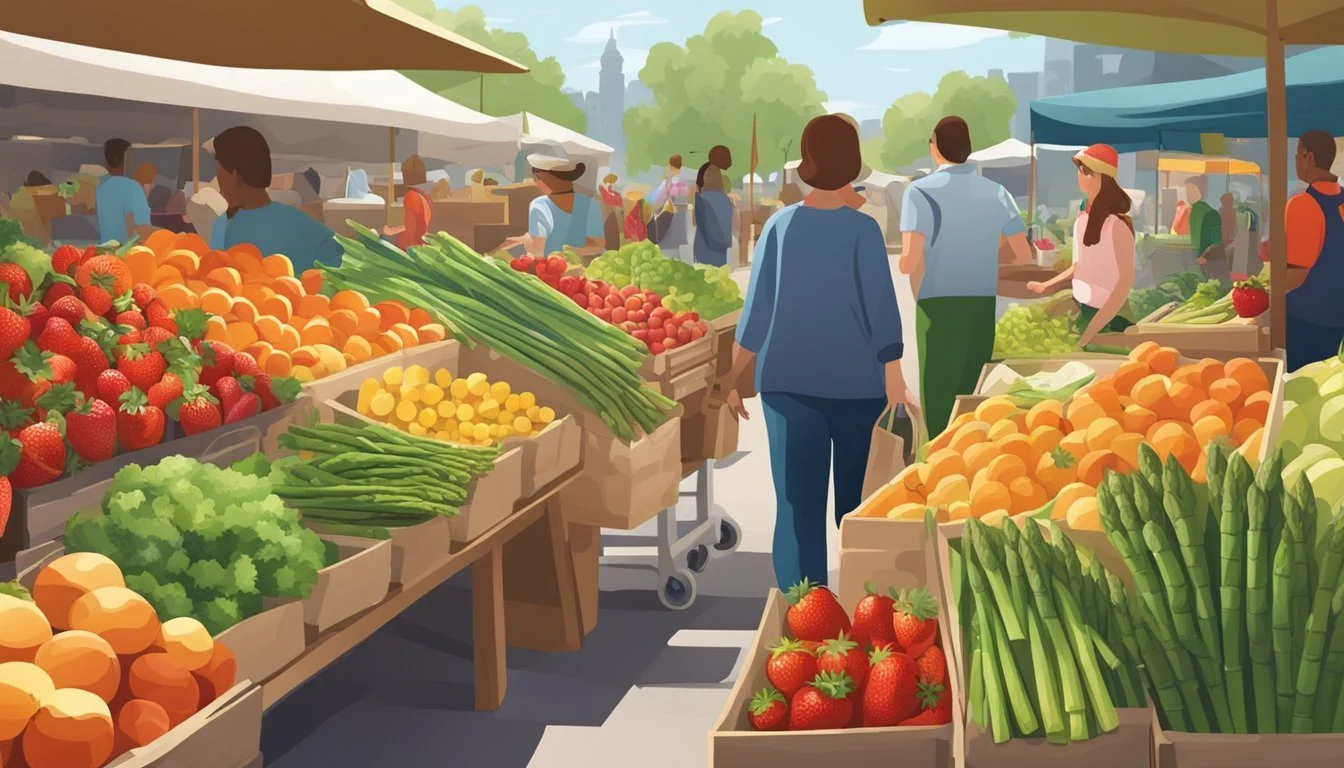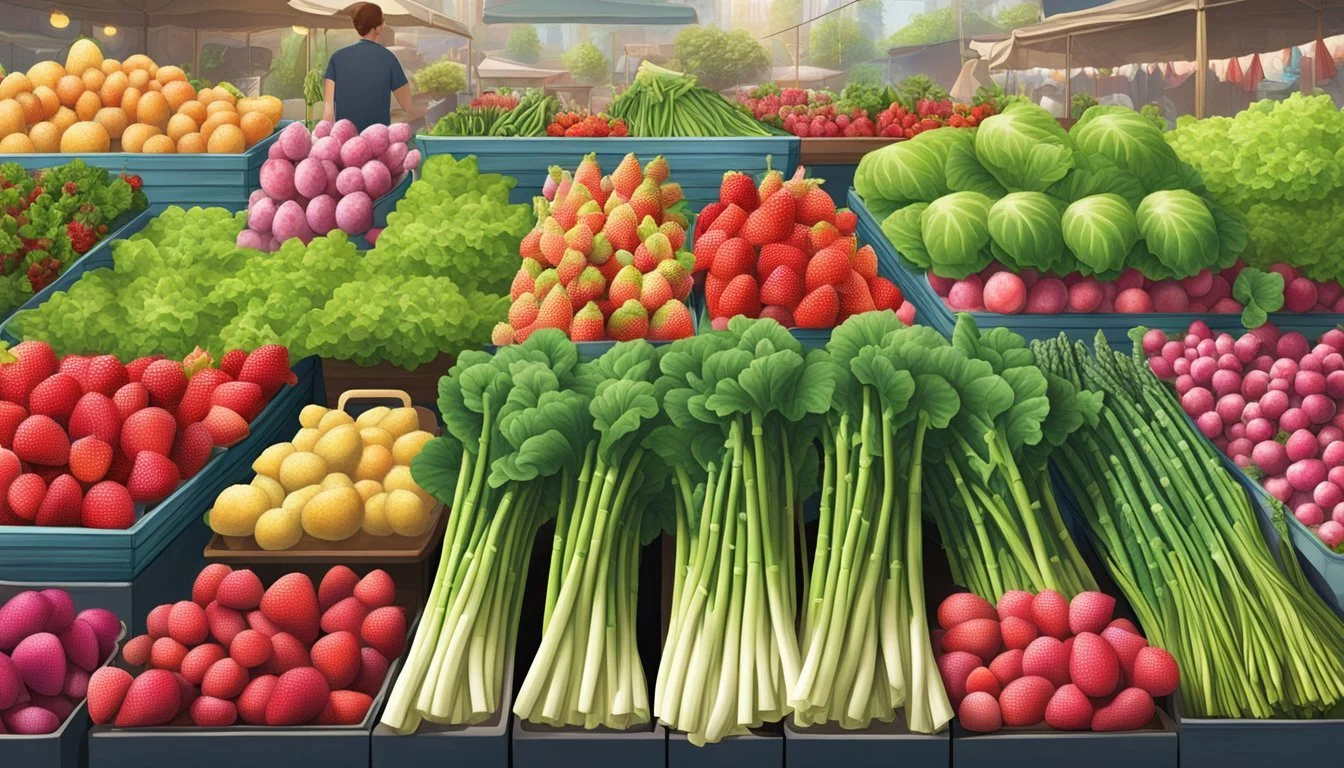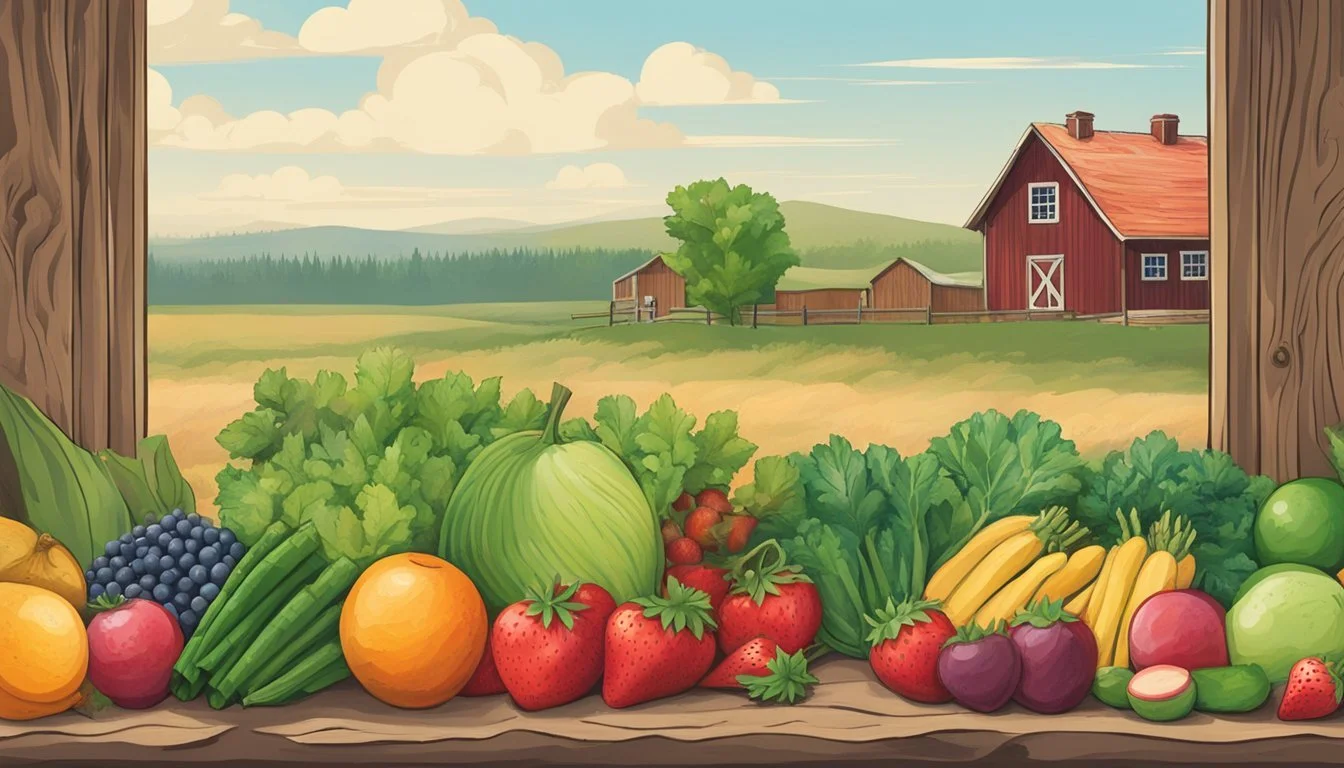North Dakota Seasonal Fruit & Vegetables in May
Your Fresh Guide
This Article is Part of our North Dakota Seasonal Fruit & Veg Calendar
In North Dakota, the arrival of May signals a transition in the agricultural calendar as a variety of fruits and vegetables begin to reach their peak season. This period is marked by longer days and a gradual warming trend, offering optimal conditions for the growth of certain crops. Consumers looking for fresh produce during this time will find that the local offerings are not only abundant but also boast superior flavor and nutritional content compared to out-of-season imports.
The selection of produce available in May can vary depending on factors such as weather patterns and specific regional climates within the state. However, typical items starting to appear at farmers' markets and grocery stores include the first tender shoots of asparagus (What wine goes well with asparagus?), a range of crisp leafy greens, and hardy root vegetables like radishes and beets. These crops are often celebrated for their freshness this time of year, finding their way into seasonal recipes that highlight their natural tastes and textures.
For those eager to incorporate local North Dakota produce into their diets, May presents a prime opportunity to experience the benefits of eating seasonally. By choosing fruits and vegetables that are harvested at their peak, consumers not only support local agriculture but also enjoy produce that is at its most flavorful and nutritious state. As the month progresses, the variety and volume of produce will continue to expand, laying the foundation for a bountiful season ahead.
Understanding North Dakota's Growing Season
North Dakota has a growing season that varies significantly across the state due to its climate and geography. The key to successful gardening and farming in North Dakota is understanding these variables, especially in the transitional period of spring.
Spring Harvest
In May, North Dakota gardeners and farmers see the beginning of the spring harvest season as weather conditions start to improve. While the risk of frost looms until late spring, hardy vegetables like radishes, lettuce, and kale are commonly planted in this period as they can tolerate the cooler temperatures. The following captures common vegetables harvested in spring:
Lettuce: Includes varieties such as buttercrunch and iceberg
Root Vegetables: Radishes and beets are usually safe to plant
Leafy Greens: Kale is resilient against the colder nights
Climate and Geography Impact
North Dakota's climate is characterized by cold winters and relatively short, warm summers. The state falls largely within USDA Hardiness Zones 3 and 4, with the last frost dates ranging from late May to early June.
Frost Dates: Last spring frost dates are crucial for determining planting schedules.
Temperature: Warm days above freezing signal the time to harden off seedlings.
The geography of North Dakota, with its flat plains in the east and rolling hills to the west, further influences local microclimates. Gardeners must consider these factors when approaching the spring growing season.
Seasonal Fruits Available in May
In May, North Dakota’s temperate climate nurtures the growth of a select variety of fruits. The focus is primarily on the early berries and some resilient tree fruits that are ripe for picking during this time of the month.
Berries
Strawberries: The first flush of strawberries becomes available in North Dakota this month, offering sweet and juicy flavors.
Rhubarb (technically a vegetable but often prepared as fruit): Often paired with strawberries, rhubarb is abundant and ready to be transformed into pies and desserts.
Tree Fruits
May often sees limited activity for tree fruits due to North Dakota’s colder climate delaying many fruits' availability. However, some hardy varieties suited to the region may begin to show, depending on the year's specific weather patterns.
Seasonal Vegetables Available in May
May in North Dakota brings an abundance of fresh vegetables as the weather warms up. Gardeners and farmers markets start to fill with a variety of produce, especially leafy greens and early root vegetables.
Leafy Greens
May marks the prime time for leafy greens in North Dakota. Residents will find:
Kale: A hardy green, high in vitamins, perfect for salads and smoothies.
Lettuce: Crisp and fresh, lettuce is a staple for salads and sandwiches.
Spinach: Known for its iron content, spinach (What wine goes well with spinach?) is versatile for both raw and cooked dishes.
Root Vegetables
A selection of root vegetables becomes available in May, signifying the start of the planting season:
Radishes: With their peppery flavor, radishes add a crisp bite to salads.
Asparagus: Though technically a shoot, asparagus is tender and well-suited for quick steaming or roasting.
Assorted Vegetables
Other vegetables also come into season, providing variety to the local diet:
Green Onions/Scallions: These offer a mild onion flavor to a multitude of recipes, from garnishes to grilled dishes.
Peas: Fresh peas start to appear, sweet and perfect for salads or light steaming.
Gardening and Harvest Tips
May in North Dakota signals the transition from spring to early summer, a critical time for gardeners to plant and prepare for the harvesting phase. Proper timing and pest management are essential for a successful yield.
Planting Advice
One can begin sowing peas, spinach, and carrots in their garden around May 10th, as these cool-weather crops germinate well during this period. Initiating sweet potatoes, cucumbers, and winter squash indoors ensures they have a strong start before transplanting. Gardeners should also utilize this time to prep their gardens for the warmer months, which may include:
Aerating the soil to improve nutrient absorption.
Fertilizing to replenish nutrients, particularly after the last frost.
Preparing pest control measures to protect young plants from the common pests that emerge in late spring.
Harvesting Guidance
Early crops planted in the previous season may be ready for harvest. Gardeners should keep a watchful eye on harvest times to ensure vegetables are picked at their peak quality. Some general guidelines for harvesting include:
Peas and spinach: Harvest these when they are tender and before they become too large or tough.
Herbs: Pick regularly to encourage continued growth throughout the summer.
For later-planted crops, remember that the actual harvest date may extend beyond May and into summer months, depending on the plant variety and local climate conditions.
By following these tips, one can enjoy a bountiful and vibrant garden throughout the growing season.
Health Benefits and Usage
In May, North Dakota's seasonal produce offers a blend of flavors and health benefits. These fruits and vegetables provide essential nutrients and can be incorporated into a wide range of culinary creations.
Nutritional Value
Seasonal fruits and vegetables harvested in May typically have higher nutrient content because they are picked at peak ripeness. For instance, asparagus, one of the vegetables available during this month, is rich in fiber, folate, and vitamins A, C, E, and K. Leafy greens, such as spinach and lettuce, also become abundant and offer an excellent source of iron and calcium.
Fruits like rhubarb make their appearance, providing valuable nutrients such as dietary fiber, vitamin C, and calcium. The fresh produce of May ensures a diverse consumption of vitamins and minerals that support overall health, contributing to immune system function and chronic disease prevention.
Culinary Uses
Each seasonal fruit and vegetable brings its own unique flavor profile that can enhance various dishes. Asparagus, with its tender stalks and earthy taste, is versatile and can be roasted, grilled, or steamed. It's perfect for light spring salads or as a side dish.
Rhubarb, known for its tartness, is commonly used in desserts like pies and crumbles. It can also be cooked down into a compote to complement savory dishes. Incorporating seasonal fruits and vegetables into meals not only broadens flavor experiences but also maximizes the nutritional benefits of each dish.
Local Markets and Availability
In May, consumers can visit local markets within North Dakota to find a limited selection of fresh produce. During this month, the region's seasonal yield is just beginning to flourish, as many fruits and vegetables are not yet at their peak availability.
Local farms and city markets operate predominantly on the fresh yield that they can provide. If one is seeking locally-grown produce, the options in May are sparse but start to include early season crops like radishes and greens, which can be found at farmers' markets or through direct purchase from the farms themselves.
Farmers' Markets: In North Dakota, these communal spaces start to feature spring produce, including:
Radishes
Leafy Greens (e.g., spinach and lettuce)
Herbs
These markets also tend to offer various other foodstuffs like honey and preserves, which are available year-round.
Availability in Grocery Stores:
While supermarkets may offer a more consistent supply of various fruits and vegetables due to importing from different regions, the most authentic seasonal and local produce in North Dakota is typically found closer to the fall.
Farm Stands and Roadside Stands:
For those looking to support local agriculture directly, some farm stands start to open in May, offering a selection of whatever is in season. It's recommended to verify the availability and operating hours as these can be variable.
In summary, while the options are more limited in May compared to the bountiful months of late summer and autumn, one can still find freshly grown items that are characteristic of the North Dakota region's early harvest at local markets and farms.
Seasonal Cooking and Recipes
In May, North Dakota's seasonal produce offers a bounty of fresh flavors perfect for home cooking. Utilizing in-season fruits and vegetables not only provides peak nutrition but also enhances the flavor of culinary creations.
Fruits: Chefs recommend incorporating strawberries and raspberries into recipes due to their freshness and availability. They make excellent additions to salads, desserts, and as toppers for breakfast cereals or yogurts.
Vegetables: The array of vegetables available includes peas, broccoli (how long does broccoli last?), carrots, and cauliflowers. These can be roasted to deepen their taste, or included in stir-fries and stews for a nutritionally dense meal.
Recipes: Here are some suggestions for incorporating May's produce into everyday cooking:
Strawberry and Spinach Salad: A simple dish accentuating the sweetness of strawberries with the earthy tones of spinach.
Pea and Mint Soup: A refreshing option that showcases the vibrancy of fresh peas, partnered with the coolness of mint.
Roasted Carrots and Broccoli: This side dish benefits from the caramelization of roasting, which brings out the natural sugars in the carrots and the nuttiness of broccoli.
For each of these dishes, the goal is to let the natural flavors of the produce shine through, with seasonings used to complement, not overpower, the taste profile of each ingredient. Chefs advise seasoning with a light hand and choosing quality produce to get the best results. This approach to cooking if thoughtful and delicate, successfully elevates the dining experience through the essence of May's seasonal offerings.
Agricultural Practices in North Dakota
North Dakota's agricultural sector is shaped by its commitment to sustainable and organic farming practices. These practices are vital for maintaining soil health and ensuring the continued productivity of the land.
Sustainable Farming
Farmers in North Dakota employ sustainable farming techniques to protect the environment while producing crops and livestock. Sustainable practices include crop rotation to improve soil fertility and prevent pest cycles, cover cropping to prevent soil erosion, and integrated pest management to minimize chemical use. Research is continually conducted to enhance these practices and ensure that agriculture remains both economically and environmentally viable in the state.
Crop Rotation: They commonly cycle through crops like wheat, soybeans, (how long do soybeans last?) and corn.
Cover Cropping: Typical cover crops include rye or clover.
Pest Management: Tactics vary, but they often combine biological, cultural, and chemical controls with close monitoring.
Organic Production
Organic production is on the rise in North Dakota, with farms meeting stringent guidelines to ensure products are free from synthetic fertilizers and pesticides. Organic farmers in the state focus on maintaining high soil quality and supporting biodiversity on their farms. They often rely on natural processes and materials for farming operations.
Soil Practices: Use of compost, green manure, and crop rotation to maintain soil health.
Pest Control: Biological pest control and manual weeding instead of chemical herbicides.
Certification: Farms undergo regular inspections for organic certification.
The practices fostered in North Dakota ensure that agriculture remains sustainable and capable of producing a diverse range of organic and conventional crops for future generations.
State Programs and Research
In North Dakota, the Department of Agriculture plays a crucial role in researching and promoting seasonal fruits and vegetables. They provide valuable data and guides that help both consumers and farmers understand what produce is available throughout the year. For example, in May, asparagus, beans, beet, broccoli, and other vegetables begin to flourish.
Research Initiatives: North Dakota State University (NDSU) conducts extensive research on plant sciences, including horticulture studies relevant to the state's climate. Their research provides insights on supporting healthy growth in the local produce, such as determining the best practices for supporting tomato vines in May.
Educational Outreach: NDSU Extension specialists work to disseminate research findings to the agricultural community and general public, ensuring knowledge transfer from academic research to practical applications.
Highlighted Programs:
Seasonal Eating Guides: Information provided by the Department of Agriculture helps residents identify what is fresh and local throughout the seasons.
Field Days: NDSU hosts events, such as the Horticulture Research Farm field day in September, offering a preview of research and what produce is expected to be available in the coming months.
The state's dedication to Agriculture and Research ensures that both consumers and producers in the United States have access to the latest agricultural data, emphasizing the importance of local, seasonal consumption.
Table: Seasonal Produce in May
Vegetable Availability Asparagus May Beans May Beets May Broccoli May Others (Full list available through the Department of Agriculture guides) May
These initiatives reflect a commitment to sustainable and informed agricultural practices in North Dakota.
Seasonal Calendar and Guides
In North Dakota, understanding the seasonal availability of produce can aid consumers in making informed decisions about their purchases. May marks the transition from spring into summer, and with it comes a shift in the seasonal produce calendar. During this month, consumers can expect to find the tail-end of some spring vegetables, as well as the beginning of summer's bounty.
Seasonal Availability in May:
Vegetables:
Asparagus: Available
Radishes: Available
Rhubarb: Peak season
Spinach: Available
Fruits:
Strawberries: Becoming available at the end of the month
The seasonal guides suggest that while some fruits such as strawberries start to appear in markets by the end of May, vegetables like asparagus and rhubarb are readily available throughout the month. Consumers can enjoy these fresh options as they are at their peak.
The transition from April's offerings into those characteristic of June and July is gradual. Fruits and vegetables that begin their season in May continue to be available in the coming months, often reaching their peak as the season progresses. For instance, strawberries that appear in May will become more plentiful and likely reach peak freshness in June.
It's important for consumers to refer to local resources, such as the North Dakota Department of Agriculture, for the most accurate and up-to-date information on produce availability. Local conditions and weather play a significant role in the timing and quality of the harvest, affecting both the starting and ending dates of a given produce season.
Frequently Asked Questions
In this section, readers will find practical advice for purchasing and maintaining the freshness of seasonal fruits and vegetables in North Dakota during the month of May.
Buying Tips
When shopping for seasonal produce in North Dakota, consumers should look for beets, broccoli, cabbage, and carrots, as these are typically harvested in May. Visitors to local markets should:
Inspect produce for freshness; firm texture and vibrant color can be indicators of quality.
Ask vendors for the origins of their produce to ensure it's locally sourced, which could mean better flavor and freshness.
Storage Advice
Proper storage prolongs the life of fruits and vegetables, preserving taste and nutritional value. Key storage tips include:
Beets: Store in the refrigerator's crisper drawer; trim the tops to prevent moisture loss.
Broccoli: Keep in a perforated plastic bag in the crisper; do not wash until ready to use.
Cabbage: Refrigerate in a plastic bag; it can last up to two weeks.
Carrots: Remove any greens and store in the coolest part of the fridge in a sealed bag.
Proper storage techniques help maintain the freshness and flavor of North Dakota's seasonal produce through May and beyond.
Conclusion
In North Dakota, the approach of May signals a shift in the local produce landscape. Residents and chefs alike can look forward to an emerging variety of fresh, seasonal produce that begins to flourish at this time. Markets start to fill with the early bounty of spring, and the presence of certain fruits and vegetables becomes more prominent.
Seasonal Fruits and Vegetables in North Dakota during May:
Vegetables: Asparagus, radishes, and lettuce typically reach their peak, offering crisp textures and fresh flavors ideal for spring salads.
Herbs: Fresh herbs, like chives, begin to sprout, enhancing the flavors of numerous dishes with their vibrant colors and aromas.
It's advisable for consumers to connect with local farmers or visit farmer's markets to ensure they are purchasing the freshest produce available. Doing so not only provides support to the local agricultural community but also ensures that fruits and vegetables are at their optimal taste and nutritional value.
To incorporate these seasonal offerings, they should consider simple preparations to let the natural flavors shine. Grilled asparagus (What wine goes well with grilled asparagus?) or salads featuring crisp radishes and tender lettuce are just a few options.
This season serves as a reminder of the rhythms of the natural world, and those who go after these seasonal foods typically find that they taste better and perhaps, have a greater nutritional profile due to their freshness. As the seasons progress, North Dakotans will witness a changing palette of produce, but in May, the focus is on enjoying the first harvests that spring offers.













